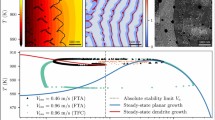Abstract
The distinction between first-order and second-order phase transformations is brought out. The general characteristics of first-order transformations are described. The salient features of transformations controlled by long-range diffusion, short-range diffusion and by (diffusionless) shear mechanisms are discussed. Martensitic trasnformations, which belong to the shear category, occur in many metallic and non-metallic systems and deserve an intensive study.
Similar content being viewed by others
References
Bowles J S and Mackenzie J D 1954Acta Metall. 2 129, 138, 224
DiDomenico M Jr and Wemple S H 1967Phys. Rev. 155, 539
Christian J W 1975The theory of transformations in metals and alloys Part I (Oxford: Pergamon Press)
Raghavan V and Cohen M 1975Solid-state phase transformations in Treatise on solid state chemistry 5 Chap.2 (New York: Plenum Press)
Weschler W S, Lieberman D S and Read T A 1953Trans. AIME 197 1503
Author information
Authors and Affiliations
Rights and permissions
About this article
Cite this article
Raghavan, V. Some characteristics of first-order phase transformations. Bull. Mater. Sci. 1, 171–179 (1979). https://doi.org/10.1007/BF02743965
Received:
Issue Date:
DOI: https://doi.org/10.1007/BF02743965




